Kigelia pinnata - Sausage Tree
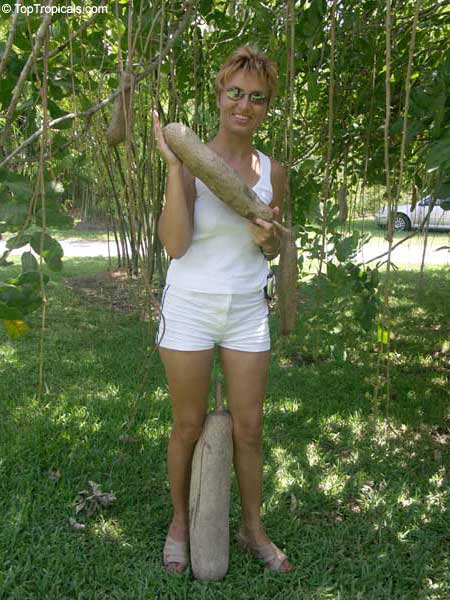
Scientific name: Kigelia
pinnata
Common names: Sausage Tree, Kigelia Africana, Cucumber Tree
Family: Bignoniaceae
Origin: South and South-East Africa
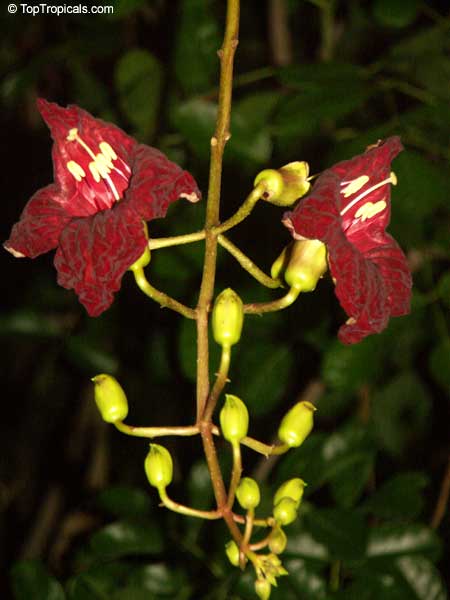
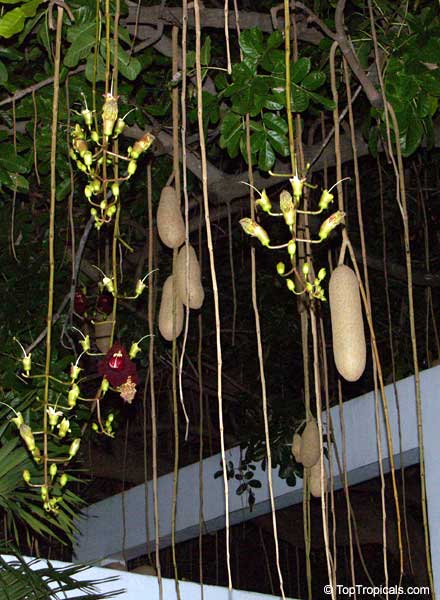
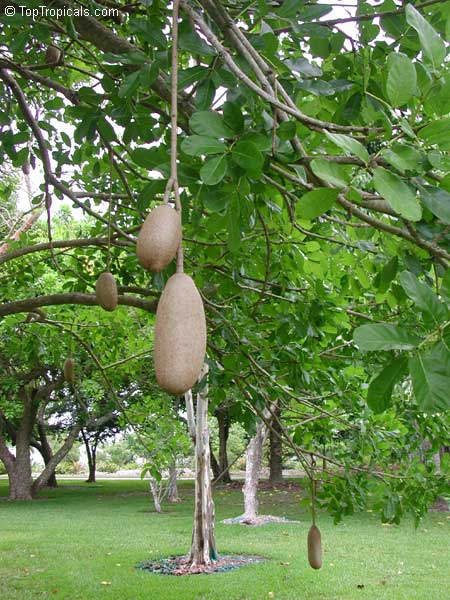 First
time we saw the Sausage Tree when we just moved to South Florida and visited
The Fairchild Botanical Garden.
First
time we saw the Sausage Tree when we just moved to South Florida and visited
The Fairchild Botanical Garden.
Kigelia Pinnata is originated from South and South-East Africa. In habitat it's found on riverbanks, where it may reach 50 feet, along streams and on floodplains, also in open woodland.
The genus name Kigelia came from Swahili language (used in Kenya and Tanzania). Unfortunately, we could not find out the meaning of this word in Swahili language.
The species name pinnata means feather-like. Quite a big feather! However, the leaves might look a bit feather-like, which makes the tree attractive even while it's "sausage-free".
One of the native names of that tree is Moporoto, which means "sheep's thick tail". Don't try to imagine how big that sheep is. Another name is Omuhaka. Nobody could tell us what that means but who cares it just sounds cool when you say "Oh, muhaka!"...
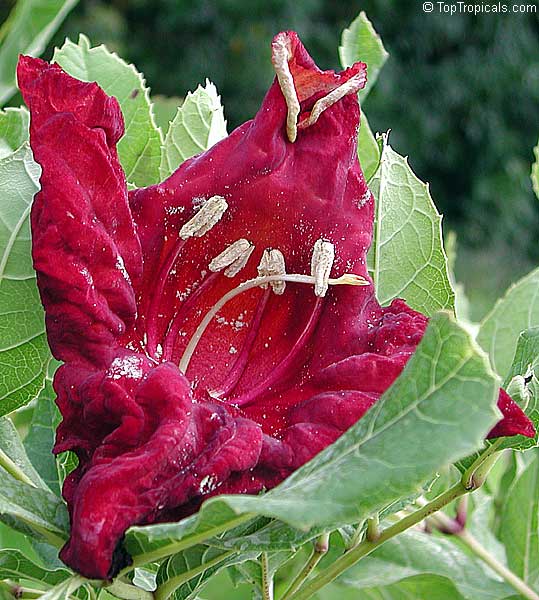 It's
a real fast-grower, so if you are planning on planting this tree in your garden
remember: along with a shady crown you'll get something else. The mature fruits
hang from the long stalks like giant sausages. They may be up to 3 feet long
and weigh up to 30 pounds. So, having this tree in your backyard might be
tricky. At the beginning the fruits are small and it takes them a few months
to grow and ripen but when they are ready you really have to watch out (or
watch up). Parking your car under that tree is not such a good idea.
It's
a real fast-grower, so if you are planning on planting this tree in your garden
remember: along with a shady crown you'll get something else. The mature fruits
hang from the long stalks like giant sausages. They may be up to 3 feet long
and weigh up to 30 pounds. So, having this tree in your backyard might be
tricky. At the beginning the fruits are small and it takes them a few months
to grow and ripen but when they are ready you really have to watch out (or
watch up). Parking your car under that tree is not such a good idea.
The trunk of a Sausage Tree has light brown, sometimes flaky bark and supports a dense rounded to spreading crown of leathery, slightly glossy foliage.
It blooms from August to November. The blood-red tulip-shaped flowers of the sausage tree open one at a time at night on long, rope-like stalks that hang down from the limbs of this tropical tree. In their native habitat the blossoms are pollinated by searching for nectar bats, insects and sunbirds. Although the flowers are beautiful, odor is quite unpleasant for humans. It's not as strong as Mr. stinky's (Amorphophallus) smell but it is irritating.
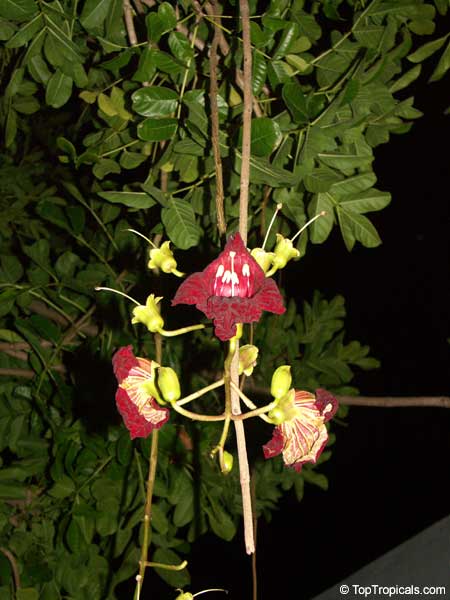 The
Sausage Tree belongs to the bignonia (Bignoniaceae) family along with such
plants as Jacaranda (Jacaranda mimosifolia), Cape Honeysuckle (Tecomeria capensis),
Common Catalpa (Catalpa bignonioides), African tulip tree (Spathodea campanulata),
Trumpet Tree (Tabebuia).
The
Sausage Tree belongs to the bignonia (Bignoniaceae) family along with such
plants as Jacaranda (Jacaranda mimosifolia), Cape Honeysuckle (Tecomeria capensis),
Common Catalpa (Catalpa bignonioides), African tulip tree (Spathodea campanulata),
Trumpet Tree (Tabebuia).
Special uses
Kigelia pinnata has a long history of use by rural African tribes, but very
little had been documented.
The wood of the Sausage Tree is very soft so it's not valued by constructors
and craftsmen. But it burns very well and moreover, the fruits ("sausages")
burn even better.
For many thousands of years the massive trunk of the Sausage Tree was used
to build a canoe (Mekoro).
Sausage Tree found its use even in music. Native xylophone is made of Sausage
Tree wood.
Unfortunately, even such a "delicious" name doesn't make this fruits
edible. Seeds however can be eaten only if roasted. Raw seeds are poisonous.
Ethnomedical use
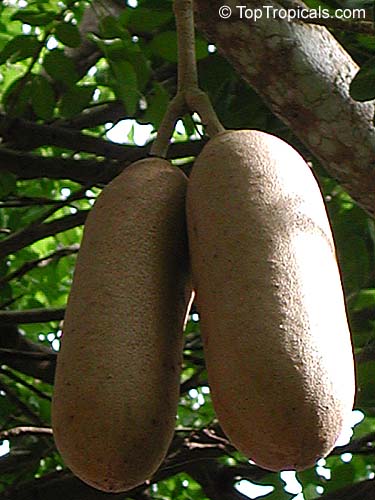
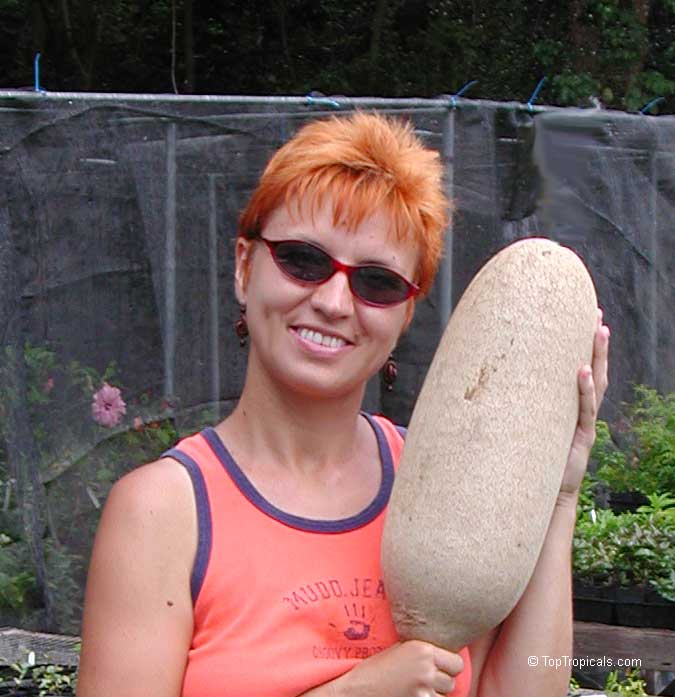 Traditional
African healers use the Sausage tree to treat a wide range of skin problems,
from fungal infections, boils, psoriasis and eczema, to the more serious diseases,
such as leprosy, syphilis and skin cancer.
Traditional
African healers use the Sausage tree to treat a wide range of skin problems,
from fungal infections, boils, psoriasis and eczema, to the more serious diseases,
such as leprosy, syphilis and skin cancer.
It also has internal applications, including the treatment of dysentery, ringworm,
tapeworm, malaria, diabetes, pneumonia and toothache. The leaves in a compound
applied for backache.
The Tonga women of the Zambezi valley apply cosmetic treatments of Kigelia
fruit to their faces to improve the skin.
The fruit of Kigelia is a common ingredient in traditional beer, and is said
to hasten the fermentation process.
Hanging a fruit around a house will protect you from violent storms and hurricanes.
It is also a symbol of fertility.
Perhaps not surprisingly, given its suggestive shape, the fruit has also found
traditional use as an aphrodisiac.
Up to the roof in no time
Kigelia's seeds are very easy to germinate.
The plant develops very fast if you just follow these rules: water regularly
during the first year and provide tree with a big container if you can't grow
it in ground. In a few years you'll get a mature tree blooming and "sausaging"!